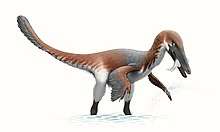Martinavis
Martinavis is a genus of enantiornithine birds which existed in what is now southern France, North America and Salta Province, Argentina during the late Cretaceous period. It was named by Cyril A. Walker, Eric Buffetaut and Gareth J. Dyke in 2007, and the type species is Martinavis cruzyensis.
| Martinavis | |
|---|---|
| Scientific classification | |
| Kingdom: | Animalia |
| Phylum: | Chordata |
| Clade: | †Enantiornithes |
| Clade: | †Euenantiornithes |
| Genus: | †Martinavis Walker, Buffetaut & Dyke, 2007 |
| Type species | |
| †Martinavis cruzyensis Walker, Buffetaut & Dyke, 2007 | |
| Species | |
| |
M. cruzyensis is known from the holotype ACAP-M 1957, a complete uncrushed right humerus, recovered from the Massecaps locality, Cruzy, which is in a Campanian/Maastrichtian-stage deposits in the Grès à Reptiles Formation of France.
A second species, M. vincei is known from the holotype PVL 4054, a complete left humerus and from the associated paratype PVL 4059, a distal end of left humerus, recovered from the El Brete locality (Maastrichtian age), Lecho Formation of Argentina.
A possible third species is represented by the unnamed specimen KU-NM-37 from United States.
In 2009, three additional species were named from the same location as M. vincei:
- M. minor is known from the holotype PVL 4046, a distally imperfect right humerus
- M. saltariensis is known from the holotype PVL 4025, an incomplete left humerus, lacking the median ridge
- M. whetstonei is known from the holotype PVL 4028, a distally imperfect left humerus
M. vincei is the largest of the El Brete taxa, approaching its huge (by enantiornithine standards), sympatric and coeval Enantiornis in size. M. saltariensis is somewhat smaller. M. minor is notably smaller than the former two, while M. whetstonei was a diminutive version of M. vincei, being at most half its size. In addition to size, the species differ slightly in proportions and qualitative features, making it unlikely the represent sexual or age variation.[2]
As few elements are known from El Brete Martinavis, it might be the same species as one of the other enantiornithines of that locality which were described earlier based on from leg bones. While the tarsometatarsus of Yungavolucris seems too wide (and short) to match Martinavis, and Lectavis was slightly larger (and its tibiotarsus differs from one tentatively assigned to Martinavis), the Soroavisaurus tarsometatarsus is about the size expected for M. vincei and perhaps M. saltariensis. These differ slightly in size but also in proportions, meaning M. saltariensis, while generally smaller, might nonetheless have had thicker legs, and thus match Soroavisaurus.[2] As Yungavolucris is assumed to be a foot-propelled swimmer however the synonymity of at least some Martinavis specimens with it could explain the genus' prevalence in marine biomes.[3]
References
- Cyril A. Walker and Gareth J. Dyke (2009). "Euenantiornithine birds from the Late Cretaceous of El Brete (Argentina)" (PDF). Irish Journal of Earth Sciences. 27: 15–62. doi:10.3318/IJES.2010.27.15. Archived from the original (PDF) on 2012-03-20.CS1 maint: uses authors parameter (link)
- M. K. Brett-Surman, Thomas R. Holtz, James Orville Farlow, The Complete Dinosaur, Indiana University Press, 2012



.png)





.png)


